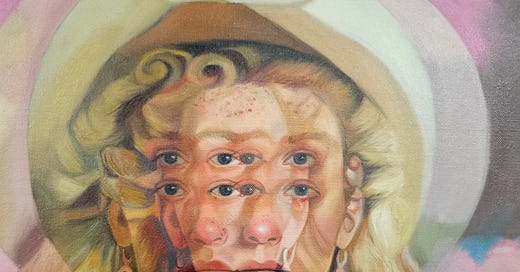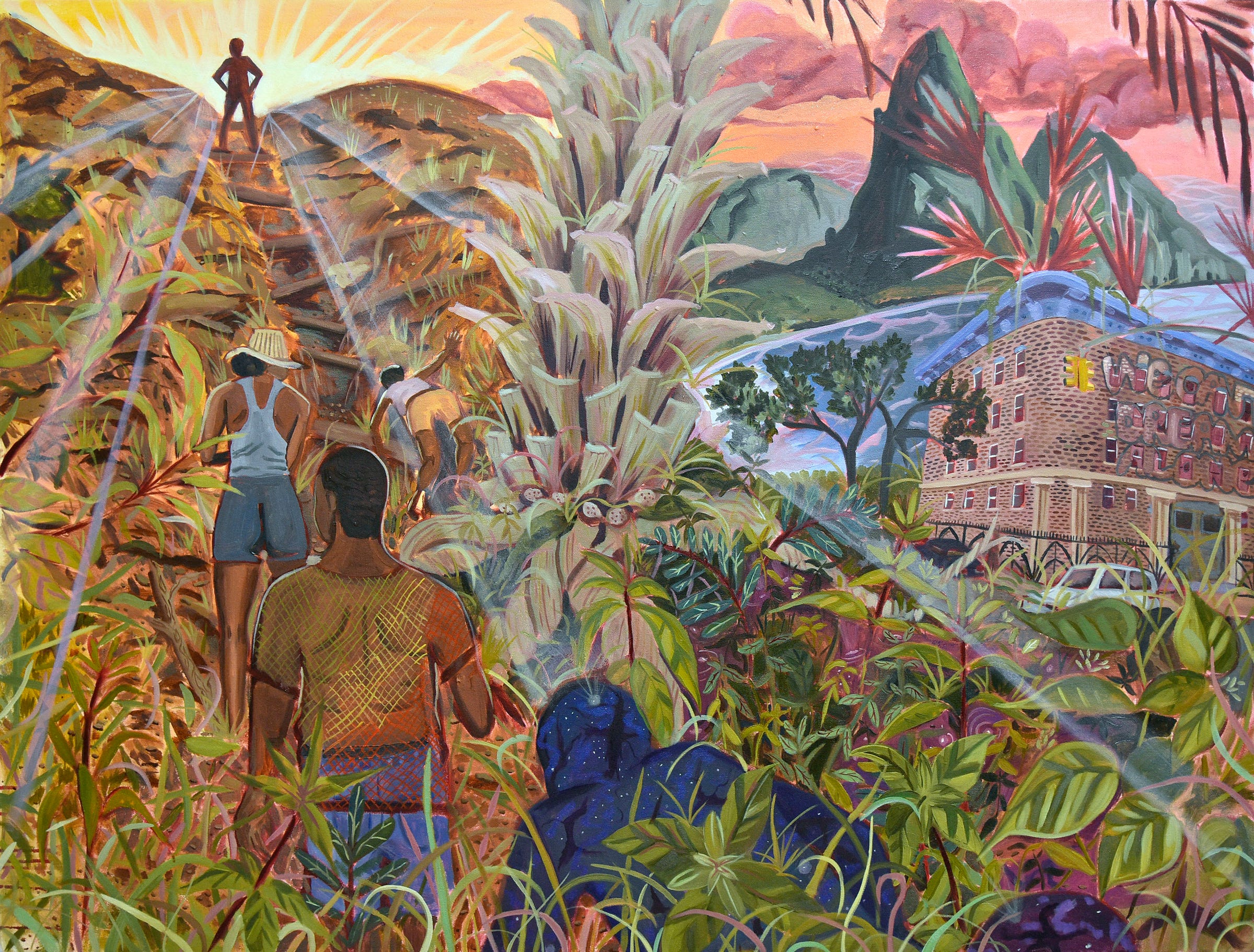Hello Everyone!
I hope you’ve all been well since our last review. I’ve been enjoying the warmer weather and all the opportunities it finally presented to enjoy being outside. This week is very exciting because it includes our first artist interview together! I met the artist, Madjeen Isaac last week and was able to ask her a few questions for my readers. We’ll expand more on her and her practice further down. For now here are the galleries I was able to visit since out last recap.
Gallery Openings:
This update is a little woozy, we’ll be focusing on show’s from last week, since those stood out to me the most. Out of the exhibitions I visited, Alex Garant’s “Dream Wrangler” at Harman Projects and Olivia Springberg “You Abnormal” at Storage APT caught my attention.
Alex Garant’s “Dream Wrangler” at Harman Projects
Garant’s work splits the figure into mirages and creates a hypnotic Americana landscape for her viewers to get lost in. Her figures stare defiantly outward; their gaze is unwavering, though their physicality is unsteady. Each work creates multiple points of contact for the audience to focus and unfocus on. I found my eyes jumping through the layers of bodies in the foreground. Each afterimage creates an impression on the canvas, which causes viewers to sway through the work and slowly gather a complete image of what’s being represented. The artworks showcased elements of the Americana through fashion, including the cowboy hat motif that appears in several works.
Interestingly enough, though I believed to have seen a strong Midwestern American aesthetic, Garant is Canadian. An interview with the artist on the Harman Projects website gave me more insight into her origin, practice, and inspiration for the show.
6) Your new solo show, Dream Wranglers, opens next month at Harman Projects New York City. Can you tell us a little bit about the inspiration for that exhibition?
AG: This whole series was such a renewal of my storytelling method. In the past few years, I’ve let the characters shine without too much context, but for this series, I completely shifted my composition goals and process by infusing a lot of my own psyche into the storytelling elements. It all started by analyzing how I dream, I’m a very active dreamer. When I dream, my mind pulls so many elements from my day and life and combines them into wild stories. I followed the same method for this painting series…
Read the rest of the interview here.
Through her use of placement and superimposition, The Queen of the Double Eyes, a moniker Garant gained from her signature style, creates a dizzying world where consciousness is split. The duality of her characters forces viewers to explore the conflict between the perceived and projected.
This show will be on view from April 12 - May 3, 2025
Also, I found a picture of myself on their website from the opening night!
Olivia Springberg “You Abnormal” at Storage APT
Springberg's work made me feel as though I was viewing a being trapped in a prism. There is something mystical about her painting; as I looked upon the indecipherable expressions of her figures, I couldn't figure out what I was meant to feel or if I was meant to feel anything. The figures pictured above stand in a line with their heads facing down; their eyes are merely implied with small black dots. The haze and patterns she creates at the forefront of her canvas create a barrier between her figures and the viewers. This results in a disconnect and leaves the audience to wonder about the strange creatures and the artist's intention in their portrayal.
Springberg spoke of her practice and influences briefly during the reception. She talked about her multiple interests, including in archeology, particularly land art and geoglyphs. In her process, she describes creative labor as akin to excavating to unearth an initial image. She gradually polishes it to bring the work into realization. The inspiration for the collection stems from the fascinating intersection of Jewish heritage and dream theory, with references to Jewish kabbalistic values and Judaic imagery. Springberg reinterprets these influences to bring together a hauntingly beautiful body of work that leaves clues for viewers privy to its layered components to get a deeper read of the work.
The press release states that the title originates from a "20th-century ghost story, where a woman yells at a malicious spirit, and the activity subsides." I tried to find the tale, after some research, I'm guessing it's the story, The Haunting of Hill House (1959). But I'm completely unfamiliar with 20th-century ghost stories, so I may be wrong. If anyone has a better guess, let me know!
This show will be on view from April 10th - May 17th, 2025
Interview with Madjeen Isaac
Last week, I had the pleasure of being attending a small gathering for artists hosted by Braden Hollis and Maya Beverly. I was able to catch up with a few friends and met a few new artists. One of the artists I met was the talented Madjeen Isaac. We spoke briefly of her practice and influences at the party. I followed up with her afterward because I was moved by her work and wanted to dive more into its meanings. I hope you all enjoy learning about her practice, as much as I have.
Can you tell us a bit about yourself?
My name is Madjeen Isaac and I am an interdisciplinary artist working across painting, installation and sculpture.
I was born, raised and is currently based in Brooklyn. NY. When I’m not creating in the studio I enjoy long days at Prospect Park, a good cafe, the spa, volunteering at a community garden, hiking and camping.
Who or what has been your biggest influence?
My influences vary from artists such as Maia Cruz Palileo, Tatyana Fazlalizadeh, Nyugen Smith and Michael Armitage to name a few.
Other influences include simply being from Brooklyn. I grew up in Flatbush known as a neighborhood with a large population of Caribbean immigrants. Living in a cultural whirlwind, I’m met with sensory overload in a good way. Patois, Haitian-creole, and thick NYC accents swarm the air. Fritay, fresh baked patties and jerk chicken permeate the streets. Konpa, reggae, dancehall, calypso, soca, batcha, merugene and the latest radio hits bounced off the windows of prewar buildings and storefront businesses. Flatbush has its own cadence.
Lastly, some books I’ve been reading have been informing my practice, from Bell Hooks’ Belonging: A Culture of Place and Octavia Butler's Parable of the Sower. These books highlight Black folks and their relationship to nature/the outdoors, unpacking homeplace, leaning onto spirituality, and fostering community in the face of environmental injustices and racism social/economic disparities.
All that I’ve mentioned above contributes to my enjoyment of reimagining and world-building for sovereign futures.
Can you describe your creative process?
My creative process involves taking and collecting photographs of the spaces I occupy in order to deconstruct, make collages and draw on. I enjoy merging opposing landscapes, from architecture, to plants and animals to create odd and complex compositions. In the studio, I work on many paintings or projects at once. This allows me to formulate my own visual language in between each piece.
What themes do you explore in your work?
My practice is rooted in home, community and (be)longing. Most recently I’ve also been interested in human impact on the earth and effects of climate change.
In my paintings, I reimagine landscapes that center boundless Haitian existences, asserting presence and forging new realities post-migration. Pulling from elements of my hometown Brooklyn and ancestral homeland Haiti, I re-envision the “lakou” – a communal yard or third space born out of the Haitian Revolution. I am interested in how the concept of the lakou has changed overtime, shaped by liminality and the emotional experience of existing in one place while yearning for another.
Recurring motifs in my work include celestial beings and beams of light representing ancestral presence that exist no matter where we are in the world. Black creole pigs also appear in my works as a nod to families in Haiti who once depended on their existence as currency before the US and Canadian invasion in the late 1980’s. I pay homage to them as they represent land protection and economic stability.
My sculptures and installations are extensions of my paintings. I’m interested in ways viewers can experience the sensory aspects of the worlds I create.
Overall throughout my practice, I aim to create dream-like nostalgic portals and blueprints of sovereign futures suggesting ideal worlds where access and autonomy are reclaimed, rooted in resistance and revolution.
What are you currently working on or excited to explore next?
I’m working on so many projects both in the studio and out of the studio! I’m excited to explore my practice beyond the studio and out within varying community spaces. I look forward to offering art-making workshops in relation to my practice, specifically around world-building and dreaming about realities beyond our current constraints!
Thank you so much to Madjeen Isaac for the interview! I hope you all enjoyed this week's recap. Due to scheduling conflicts, it will be difficult for me to cover openings for the rest of April. But I'll do my best to cover as much as I can.
Looking forward to our next debrief✨








Thank you for sharing! 🤎